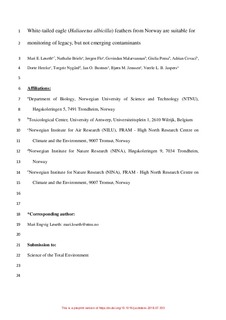White-tailed eagle (Haliaeetus albicilla) feathers from Norway are suitable for monitoring of legacy, but not emerging contaminants
Løseth, Mari Engvig; Briels, Nathalie; Flo, Jørgen; Malarvannan, Govindan; Poma, Giulia; Covaci, Adrian; Herzke, Dorte; Nygård, Torgeir; Bustnes, Jan Ove; Jenssen, Bjørn Munro; Jaspers, Veerle
Journal article, Peer reviewed
Submitted version
Permanent lenke
http://hdl.handle.net/11250/2579462Utgivelsesdato
2018Metadata
Vis full innførselSamlinger
- Publikasjoner fra Cristin - NILU [1360]
- Vitenskapelige publikasjoner [1096]
Originalversjon
Science of the Total Environment. 2018, 647 525-533. 10.1016/j.scitotenv.2018.07.333Sammendrag
While feathers have been successfully validated for monitoring of internal concentrations of heavy metals and legacy persistent organic pollutants (POPs), less is known about their suitability for monitoring ofemerging con- taminants (ECs). Our study presents a broad investigation ofboth legacy POPs and ECs in non-destructivematri- ces from a bird of prey. Plasma and feathers were sampled in 2015 and 2016 from 70 whitetailed eagle (Haliaeetus albicilla) nestlings from two archipelagos in Norway. Preen oil was also sampled in 2016. Samples were analysed for POPs (polychlorinated biphenyls (PCBs), polybrominated diphenyl ethers (PBDEs) and organochlorinated pesticides (OCPs)) and ECs (per- and polyfluoroalkyl substances (PFASs), dechlorane plus (DPs), phosphate and novel brominated flame retardants (PFRs and NBFRs)). A total of nine PCBs, three OCPs, one PBDE and one PFAS were detected in over 50% of the plasma and feather samples within each sampling year and location. Significant and positive correlationswere found between plasma, feathers and preen oil concentrations of legacy POPs and confirm the findings ofprevious research on the usefulness of these matrices for non-destructive mon- itoring. In contrast, the suitability of feathers for ECs seems to be limited. Detection frequencies (DF) of PFASs were higher in plasma (mean DF: 78%) than in feathers (mean DF: 38%). Only perfluoroundecanoic acid could be quantified in over 50% ofboth plasma and feather samples, yet their correlation was poor and not significant. The detection frequencies of PFRs, NBFRs and DPs were very low in plasma (mean DF: 1–13%), compared to feathers (meanDF: 10–57%). Thismay suggest external atmospheric deposition, rapid internal biotransformation or excretion of these compounds. Accordingly, we suggest prioritising plasma for PFASs analyses, while the sources of PFRs, NBFRs and DPs in feathers and plasma need further investigation. White-tailed eagle (Haliaeetus albicilla) feathers from Norway are suitable for monitoring of legacy, but not emerging contaminants
